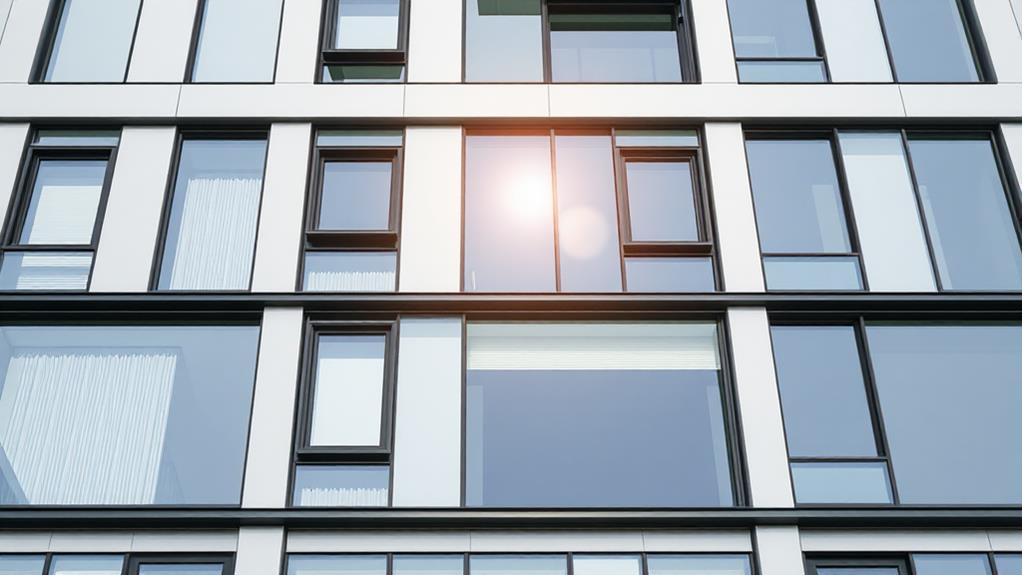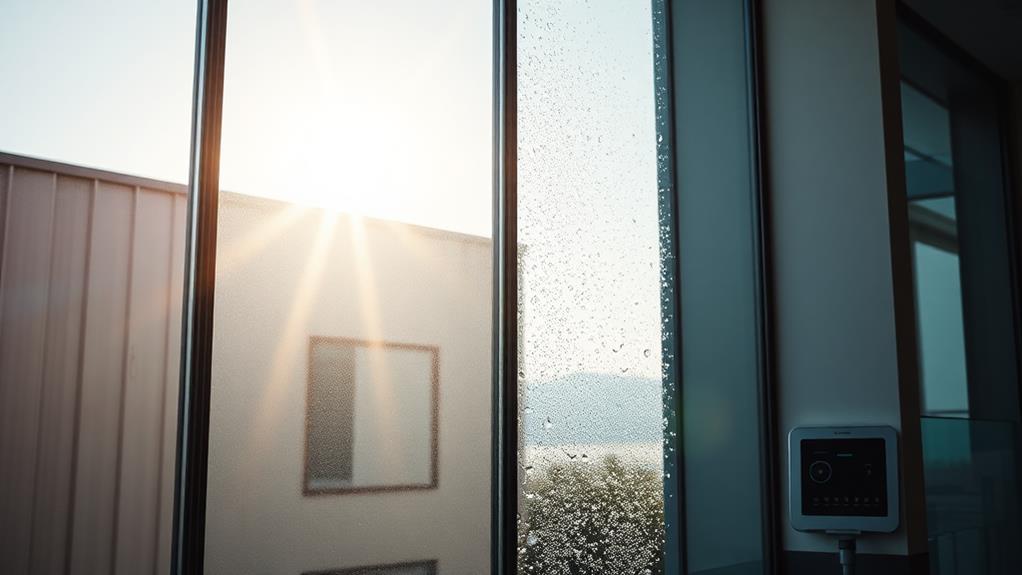Smart windows are innovative glazing solutions that adapt to changing environmental conditions. You'll find two main types: electrochromic and thermochromic. Electrochromic windows use electricity to shift ions between layers, altering their tint, while thermochromic windows respond to temperature changes through chemical reactions. Both technologies efficiently manage light and heat transmission, potentially reducing building energy costs by up to 30%. These windows integrate seamlessly with various architectural styles and can be automated through building management systems. As you explore further, you'll discover how smart windows are transforming modern architecture and energy efficiency.
The Science Behind Smart Windows

Two key technologies power smart windows: electrochromic and thermochromic materials. Electrochromic windows use electricity to change their tint. When you apply a low voltage, ions move between layers of electrochromic materials, altering their light absorption properties. This process allows you to control the window's transparency electronically.
Thermochromic windows, on the other hand, respond to temperature changes. They contain special compounds that undergo a reversible chemical reaction when heated or cooled. This reaction changes the material's molecular structure, affecting how it interacts with light. As a result, the window becomes more or less transparent depending on the ambient temperature.
Both technologies rely on advanced materials science. Electrochromic windows often use metal oxides like tungsten oxide or nickel oxide, while thermochromic windows may incorporate vanadium dioxide or polymer composites. The key to their effectiveness lies in the precise engineering of these materials at the nanoscale. By manipulating their composition and structure, scientists can fine-tune the windows' optical properties, response time, and durability. This allows for the creation of smart windows that efficiently manage light and heat transmission, improving energy efficiency in buildings.
Electrochromic Technology Explained
Electrochromic technology relies on three primary components to function effectively. These are the electrochromic layer, an ion storage layer, and an electrolyte. When you apply an electric current, ions move between the storage layer and the electrochromic layer through the electrolyte, causing the window to change its tint.
The electrochromic layer is typically made of materials like tungsten oxide or nickel oxide. It's responsible for the color change you see. The ion storage layer holds the ions when they're not in use, while the electrolyte allows for their smooth movement.
You'll find that electrochromic windows can switch between clear and tinted states in just a few minutes. They're energy-efficient, as they only require power during the transition. Once the desired tint is achieved, no additional electricity is needed to maintain it.
These windows offer you precise control over light transmission and heat gain. You can adjust them manually or integrate them with building management systems for automatic control based on factors like time of day or sunlight intensity.
Thermochromic Windows in Action

Thermochromic windows offer a distinct approach to smart window technology. Unlike electrochromic windows, they don't require electricity to change their tint. Instead, they respond to temperature fluctuations, automatically adjusting their opacity as the surrounding environment heats up or cools down.
You'll find that these windows typically contain a thin layer of thermochromic material sandwiched between glass panes. As the temperature rises, the material undergoes a chemical reaction, causing it to darken and reduce solar heat gain. When the temperature drops, the process reverses, allowing more light and heat to pass through.
You can observe thermochromic windows in action on a sunny day. As the sun's intensity increases, you'll notice the windows gradually darkening, helping to maintain a comfortable indoor temperature without the need for excessive air conditioning. This passive system can significantly reduce your energy consumption and costs.
While thermochromic windows don't offer the same level of control as their electrochromic counterparts, they're generally more affordable and easier to install. You'll find them particularly useful in buildings where simplicity and low maintenance are priorities.
Energy Savings and Efficiency
Both smart window technologies offer substantial energy savings and efficiency benefits. When you install electrochromic or thermochromic windows, you'll notice a significant reduction in your energy consumption. These windows help regulate indoor temperatures, reducing the load on your heating and cooling systems.
You'll save on lighting costs too. Smart windows allow more natural light to enter when needed, decreasing your reliance on artificial lighting. In summer, they'll block excess heat, while in winter, they'll help retain warmth inside.
Studies show that buildings with smart windows can achieve energy savings of up to 20-30% compared to those with standard windows. You'll see the most significant impact in regions with extreme temperatures or high electricity costs.
Smart windows also contribute to improved occupant comfort and productivity. By reducing glare and maintaining consistent indoor temperatures, they create a more pleasant environment. This can lead to indirect energy savings, as occupants are less likely to adjust thermostats or use personal heating/cooling devices.
When considering smart windows, factor in their long-term energy savings potential against their initial higher cost. Over time, the reduced energy bills will offset the installation expenses.
Architectural Integration and Design

Many architects and designers are embracing smart window technologies for their versatility and aesthetic appeal. You'll find that electrochromic and thermochromic windows offer seamless integration into various architectural styles, from modern to traditional. These smart windows can be customized to fit any size or shape, allowing for creative design possibilities.
When you're incorporating smart windows into your building design, you'll need to consider factors like placement, orientation, and surrounding materials. You can use these windows strategically to maximize natural light while minimizing glare and heat gain. They're particularly effective in large glass facades, atriums, and skylights.
Smart windows also offer flexibility in terms of control systems. You can integrate them with building management systems, allowing for automated tinting based on time of day, occupancy, or external conditions. This integration enhances the overall energy efficiency and comfort of the building.
As you design with smart windows, you'll find that they can contribute to achieving green building certifications like LEED. Their energy-saving properties and ability to reduce the need for additional shading devices make them an attractive option for sustainable architecture.
Smart Window Control Systems
At the heart of smart window functionality lies the control system, which governs how these innovative glazing solutions respond to environmental changes and user preferences. You'll find that these systems typically consist of sensors, processors, and user interfaces working in tandem to optimize window performance.
Sensors play a crucial role, monitoring factors like light levels, temperature, and occupancy. They feed this data to the central processor, which uses algorithms to determine the ideal window state. You can often customize these algorithms to suit your specific needs, balancing energy efficiency with comfort and aesthetics.
User interfaces allow you to override automatic settings when desired. You'll have options ranging from simple wall-mounted controls to sophisticated smartphone apps that let you adjust your windows remotely.
Many smart window control systems integrate with building management systems (BMS) for seamless operation alongside HVAC and lighting controls. This integration enhances overall energy efficiency and occupant comfort.
You'll also find that advanced systems incorporate machine learning capabilities, adapting to patterns in occupant behavior and environmental conditions over time. This results in increasingly refined and personalized window performance, maximizing the benefits of your smart window installation.
Cost Considerations and ROI

When considering smart windows, you'll need to weigh the upfront costs against potential long-term savings. Initially, smart windows are more expensive than traditional windows, with prices ranging from $50 to $1,000 per square foot. However, they can significantly reduce energy costs over time.
You'll save on heating and cooling expenses as smart windows regulate indoor temperatures more efficiently. They can cut HVAC energy consumption by up to 20%, leading to lower utility bills. Additionally, you'll spend less on window treatments and maintenance costs.
The return on investment (ROI) for smart windows varies depending on factors like climate, building orientation, and energy prices. In commercial buildings, you might see a payback period of 3-5 years. For residential applications, it could take 10-15 years to recoup your investment.
Consider tax incentives and rebates that may offset initial costs. Some regions offer financial benefits for energy-efficient upgrades. As technology advances and production scales up, prices are expected to decrease, making smart windows more accessible and improving their ROI potential.
Environmental Impact and Sustainability
Smart windows offer significant environmental benefits that extend beyond energy savings. As you consider implementing this technology, you'll find that it contributes to sustainability in several ways. Firstly, by reducing the need for artificial lighting and HVAC usage, smart windows help lower your building's carbon footprint. They decrease the demand for electricity, which often comes from non-renewable sources.
Additionally, these windows can extend the lifespan of your interior furnishings by blocking harmful UV rays. This means you'll replace furniture and carpets less frequently, reducing waste and resource consumption. Smart windows also eliminate the need for traditional window treatments, further reducing material use.
When it comes to manufacturing, electrochromic and thermochromic technologies typically use fewer harmful chemicals compared to conventional glass production. Many smart window manufacturers are also focusing on using recycled materials and implementing sustainable production practices.
At the end of their lifecycle, smart windows can often be recycled more easily than traditional windows, as they don't contain toxic materials like mercury found in some energy-efficient lighting alternatives. By choosing smart windows, you're investing in a technology that supports long-term environmental sustainability.
Future Developments and Innovations

The field of smart window technology is rapidly evolving, with researchers and manufacturers constantly pushing the boundaries of what's possible. You'll see advancements in both electrochromic and thermochromic technologies in the coming years.
For electrochromic windows, expect improvements in switching speeds, color options, and durability. Researchers are working on new materials that can change opacity faster and last longer, while also offering a wider range of tints.
In thermochromic technology, you'll witness the development of more precise temperature-responsive materials. These innovations will allow for finer control over the window's transition point, making them more adaptable to various climates. You'll also see the integration of smart sensors and artificial intelligence, enabling windows to automatically adjust based on environmental conditions and user preferences.
Another exciting area of development is the combination of electrochromic and thermochromic technologies. This hybrid approach could result in windows that respond to both electrical signals and temperature changes, offering unprecedented versatility. Additionally, you can look forward to improved energy harvesting capabilities, with smart windows doubling as solar panels to generate electricity for buildings.
Smart Windows in Practice
In real-world applications, smart windows are making a significant impact on energy efficiency and occupant comfort. You'll find these innovative windows in various settings, from commercial buildings to residential homes.
In office spaces, smart windows automatically adjust their tint based on sunlight intensity, reducing glare and heat gain. This leads to improved productivity and decreased reliance on air conditioning.
In homes, you can control smart windows through smartphone apps or voice commands, allowing you to customize your indoor environment. They'll help you save on energy bills by minimizing heat loss in winter and solar gain in summer.
Some hospitals are using smart windows in patient rooms to regulate natural light exposure, which can aid in recovery and improve sleep patterns.
Smart windows are also making their way into the automotive industry. You'll see them in luxury vehicles, where they can instantly darken to reduce sun glare and heat. In the aviation sector, Boeing's 787 Dreamliner features electrochromic windows, eliminating the need for traditional window shades and enhancing the passenger experience.
Conclusion
You've marveled at smart windows, dreaming of a future where your home adapts effortlessly. Yet ironically, as you sit in your energy-efficient bubble, you're more disconnected from nature than ever. While you're saving on bills, you're missing out on the simple joys of feeling sunlight on your skin. Sure, you're helping the environment, but at what cost to your own connection with it? Progress isn't always as clear as these windows.

